With impressive display specs, built-in inside-out tracking, and bundled controllers, The pimax crystal super promises an all-in-one solution that sidesteps some of the friction seen with other systems.
But with a price tag of nearly $1,800 USD—and several important trade-offs—it positions itself more as a flagship tech showcase than a value-driven sim racing tool.
Having already spent considerable time with the Crystal Light, Bigscreen Beyond, and Beyond 2, I’ve been able to directly compare their strengths and weaknesses. While the Crystal Super does offer some standout features, particularly in flexibility and convenience, it also presents a few critical limitations that may make it harder to recommend for many sim racers—especially when compared to more focused, purpose-built alternatives.
In this review, we’ll break down how the Crystal Super stacks up across key categories like visual clarity, audio performance, software support, ecosystem integration, and of course, the all-important driving experience.
PIMAX CRYSTAL SUPER Ratings
If our Pimax reviews have helped you decide what the best VR headset is for you, please consider using the links on this page to make your purchase. By doing so you’ll be supporting Boosted Media at no additional cost to you! This option is available for a huge range of Sim Racing gear.
VALUE: 4/10
Feature-rich but financially lopsided — premium pricing that’s hard to justify for most sim racers.
Pricing and Setup Considerations
At $1,783 USD, the Pimax Crystal Super commands a serious premium—especially when compared to other high-end VR headsets aimed at sim racers. The Crystal Light, for instance, offers a very similar overall experience for just $887 USD, while the Bigscreen Beyond 2 lands at $1,019 USD (excluding base stations). That’s a gap of hundreds of dollars, with diminishing returns the deeper you look.
While the Crystal Super boasts some impressive specs—most notably an enormous pixel count—the real-world payoff isn’t as transformative as you might expect. Achieving the headset’s full potential requires a top-tier gaming PC running cutting-edge GPUs, and even then, you’re often forced to scale resolution or settings to maintain a consistent frame rate. In practice, this means a lot of the theoretical advantage gets left on the table.
To make matters worse, the headset doesn’t present itself as a luxury device in terms of materials or construction. The shell is made from the same basic plastics used in the Crystal Light, and there’s little in the way of refinement or premium design elements to justify the nearly double price tag.
Ultimately, the Crystal Super feels like a product designed to impress on spec sheets rather than in real-world driving. If you’re looking for measurable gains in sim racing immersion or usability, you’re simply not getting value proportional to the price.
Physical Design: 6/10
Functional but uninspiring
The Pimax Crystal Super shares much of its physical design with the more affordable Crystal Light. Structurally, it’s a sturdy and well-built headset that does the job, but there’s not much here that elevates it above the rest of the Pimax range—particularly given the nearly double price tag.
The exterior is made from the same utilitarian plastics used across other Pimax models. While nothing feels flimsy or poorly made, the materials don’t exactly scream “premium” in the way you might expect from a headset priced over $1,700. Ergonomics are serviceable but not outstanding, and there are no notable improvements in balance or weight distribution over the Crystal Light. In fact, with the DMAS audio module installed, the Crystal Super weighs in at 966 grams—making it one of the heaviest headsets on the market.
Fitment is generally fine for seated sim racing in static rigs, but those using motion platforms should be aware: the stock facial interface can allow the headset to shift during aggressive movement. While not a deal-breaker, it can be distracting and may affect visual clarity. This is an area where Bigscreen has carved out a real advantage with their custom-moulded face interface—something no other manufacturer currently offers. And with the Bigscreen Beyond 2 weighing just 107g, it is a genuinely “GaMe ChAnGiNg” design.
Overall, the Crystal Super’s design is solid and gets the job done, but it doesn’t raise the bar in comfort, finish, or innovation. It’s a case of good fundamentals without the polish or thoughtful refinements you might hope for at this level.
Visual Clarity and Optics: 7/10
Big numbers on paper, modest gains in practice.
With a staggering resolution of 3840×3840 per eye—totaling nearly 30 million pixels—the Crystal Super is one of the highest-resolution consumer VR headsets available. On paper, it delivers a pixel density of up to 57 PPD depending on the configuration, which should translate to razor-sharp visuals and industry-leading clarity. But in real-world use, the improvement over the Crystal Light is far less dramatic than those numbers suggest.
Despite the resolution leap, visual clarity is only marginally better. When directly compared to the Crystal Light in sim titles like iRacing, the difference is subtle enough that you’d struggle to justify the significant price premium based on visuals alone. Much of that comes down to optical limitations. The Crystal Super uses spherical lenses, which introduce noticeable chromatic aberration and distortion outside the center of the image. The sweet spot is relatively narrow, and peripheral clarity suffers—especially when compared to headsets like the Bigscreen Beyond 2, which uses much more advanced pancake optics.
Field of view is slightly improved over the Crystal Light and Bigscreen Beyond 2, with a horizontal FOV of 127° on the 50 PPD version. It’s a welcome upgrade, but still short of what you’d get through a real helmet visor. So while it’s technically wide, it still feels constrained by physical housing and lens geometry.
The Crystal Super’s ARC LED panels offer deep blacks and decent contrast for a non-OLED display. But when viewed side-by-side with the OLED panels in the Bigscreen Beyond, the difference is stark. Colours feel flatter, and dark scenes lack the punch and richness that OLED inherently provides.
Lastly, there’s the elephant in the room: GPU load. The sheer pixel count demands top-tier hardware, and even then, you’ll likely be running below native resolution in most titles. This means the headset’s theoretical advantage is often unrealized in practice unless you’re willing to compromise on frame rate or visual fidelity elsewhere.
Sim RACING
Discount Codes
Sim Racing Experience: 7.5/10
Capable of fantastic immersion, if you’ve got the horsepower and patience.
When everything’s dialled in just right, the Crystal Super can deliver a genuinely impressive driving experience. The combination of high pixel density and wide field of view gives you great long-distance clarity for things like apexes and braking markers, while also opening up more peripheral vision within the cockpit. It’s not a revolutionary shift from the Crystal Light or Bigscreen Beyond 2, but it does offer a slightly more expansive, immersive view when the headset is performing at its best.
The challenge is getting to that “best.” Because of the massive resolution, even high-end systems like a 5090-equipped rig will struggle to run sims at full native res without compromise. You’ll need to spend time balancing render resolution, in-game settings, and motion smoothing to keep framerates consistent—especially in titles like ACC where performance overhead is already tight. It’s not plug-and-play, and unless you’ve got the patience to tweak, you’ll likely be leaving performance on the table.
The headset’s weight and face fit also play a role here. On a static rig, it holds position reasonably well, but if you’re running a motion system it doesn’t take much for the headset to shift and knock you out of the sweet spot. It’s not catastrophic, but it’s enough to break immersion and muddy the clarity during longer sessions.
That said, when you hit that balance—when your system is coping, and the headset stays locked in place—the experience is seriously engaging. The wide view, crisp centre image, and immersive audio make it feel like you’re sitting in a real cockpit. It’s not flawless, but it is very capable—if you’re prepared to work for it.
Software & Setup: 7/10
Improving steadily, but still a few rough edges to iron out.
Pimax’s software has matured a lot over time, and the Crystal Super benefits directly from that. It runs on the same Pimax Play platform as other current-generation Pimax headsets, bringing together headset setup, firmware updates, rendering modes, and tuning options into a single, relatively intuitive interface. For experienced users, it offers a lot of control, and once you know your way around, it’s capable of delivering excellent results.
That said, there are still a few quirks. During testing, IPD adjustments occasionally didn’t apply properly without restarting the software or unplugging the headset. While not a constant issue, it’s the kind of thing that adds friction to an otherwise smooth experience. The headset’s dynamic foveated rendering, enabled via the built-in eye tracking, was also inconsistent—sometimes not activating at all, and other times producing peripheral blur that felt more distracting than beneficial.
The available rendering modes—native, upscale, and various performance profiles—do give users flexibility in balancing clarity and performance. But the amount of tweaking required to find the right balance can be daunting, especially for those new to PC VR or sim racing in general. There’s no guided setup or profile tuning per title, so much of it comes down to trial and error.
On the plus side, Pimax has been rolling out regular firmware and software updates. Bug fixes and improvements are clearly ongoing, and it’s encouraging to see how much the platform has evolved. It’s not the most plug-and-play experience out there, but it’s far from the clunky, inconsistent software Pimax was known for in the past.
Audio System: 8/10
Convenient built-in audio with optional upgrades that do a good job.
The Crystal Super supports Pimax’s DMAS audio system, which can be bundled with the headset or purchased separately. These clip-on speaker modules mount to the headset arms and are designed to deliver spatial audio without the need for separate headphones.
Installation is straightforward, but not without its issues. During use, the speakers occasionally worked themselves loose—causing one side to intermittently disconnect. Tightening the mounting screws resolved the issue, but it’s something users will need to keep an eye on over time.
Platform Ecosystem and Compatibility: 7.5/10
PC-only, Steam VR, inside-out or base station tracking.
Inside-out tracking comes standard, with support for optional Lighthouse tracking via an external faceplate—ideal for those already invested in SteamVR base stations. The headset also ships with hand controllers included, making it more of an all-in-one solution out of the box compared to something like the Bigscreen Beyond 2.
You also get access to a growing suite of accessories, including swappable faceplates, optional DMAS speakers, and eventually, OLED panel upgrades. This modularity gives users the option to evolve their setup over time rather than being locked into a fixed configuration. And while Pimax’s accessory support has historically been a bit hit-or-miss in terms of availability and refinement, the trajectory is improving.
Overall Rating: 6.5/10
Impressive flagship product, hard to justify.
Conclusion
Is the Pimax Crystal Super worth it for sim racing? It depends—mostly on your hardware, and your priorities.
The Pimax Crystal Super is a headset built to impress on a spec sheet. Nearly 30 million pixels, wide field of view, dynamic foveated rendering, and all-in-one tracking out of the box—it’s undeniably feature-rich. But in practice, those features come with caveats, and many sim racers may find that the real-world gains don’t justify the $1,783 USD price tag.
If you already own a very high-end gaming PC, are comfortable with fine-tuning settings, and want maximum visual fidelity with room to expand your setup, there’s a lot here to like. When it’s running well and staying put, the Crystal Super delivers an immersive and detailed driving experience that few other headsets can match.
But for everyone else, the case is harder to make. The Crystal Light offers 90% of the visual experience for half the price. The Bigscreen Beyond 2 weighs a fraction as much, fits more securely, and looks better thanks to OLED displays and pancake optics. And both alternatives demand fewer compromises on GPU load and physical comfort.
The Crystal Super is clearly a step forward for Pimax, and a solid product in its own right. But unless your system and sim rig are already absolute top tier, it might be smarter to spend your budget elsewhere—especially if you’re chasing consistent immersion, not just big numbers.
Pros
- Extremely high resolution
- Wide field of view
- Inside-out tracking with optional base station support
- Included controllers make it usable out of the box
- Modular hardware with future upgrade path (e.g. OLED, faceplates)
- Solid audio option with DMAS add-on
- Immersive driving experience when fully optimised
Cons
- Very expensive compared to similar-performing headsets
- Real-world clarity gains are minimal over the Crystal Light
- Heavy and can shift during use on motion rigs
- High GPU demands limit practical performance
- Optical distortion and limited sweet spot
- Software still has quirks and requires effort
Related Articles
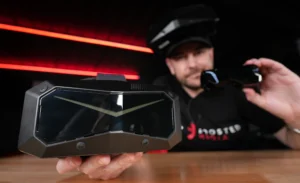
Pimax Crystal Super – Detailed Review
With impressive display specs, built-in inside-out tracking, and bundled controllers, The pimax crystal super promises an all-in-one solution that sidesteps some of the friction seen
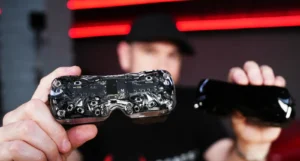
Bigscreen Beyond VR 2 – Detailed Review
After shaking up the high-end VR space with the original Beyond VR headset, Bigscreen is back with the Beyond 2 — a refined version of

Triple Screens Vs VR – Which is Faster for Sim Racing?
One of the most heated “discussions” around the Sim Racing community has got to be VR vs Triple Screens. Which is faster? Which is most
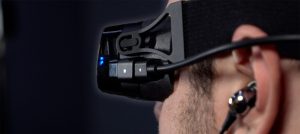
Bigscreen Beyond: Best VR for Sim Racing?
Comfort is a significant issue holding many gamers and Sim Racers back from committing to VR. And while VR offers an extremely immersive visual experience,
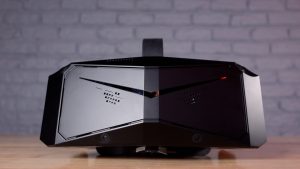
Pimax Crystal VR Headset Review
The Pimax Crystal VR Headset is undoubtedly a serious bit of kit when it comes to VR Sim Racing. With a total resolution of 5760
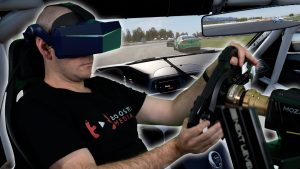
REVIEW – Pimax 5K Super VR Headset
With an epic field of view and lightning-fast refresh rate, the Pimax 5k super looks to be a great choice for VR gaming and in
MORE REVIEWS and Discounts
If these Sim Racing Reviews have helped you find the best racing simulator gear for your sim rig, please consider using the affiliate links on this website. By purchasing through these links, a small commission will come back to Boosted Media at no additional cost to you. This is how Boosted Media keeps providing content to the Sim Racing community.






















